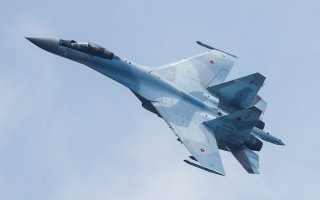Russia’s Su-35 Fighter Has an Important Edge Over America’s F-22 Raptor
The American stealth fighter isn't invincible.
Here's What You Need to Know: The F-22’s main competition, the Russian Su-35 Flanker-E, has infrared-search-and-track and cheek-mounted radars.
America’s F-22 Raptor is one of the world’s most advanced warplanes. But it has several weaknesses. For one, it’s blind in the infrared though several of its potential rivals have infrared-search-and-track sensors, effectively allowing them to scan for enemy warplanes’ heat signatures.
The last U.S. fighter to have an IRST sensor built in during development was the F-14 Tomcat. The F/A-18 Super Hornet now has the option of carrying a centerline droptank with an IRST, which will make it expensive to actually drop in combat.
The F-22 also lacks side-looking radars, which allow an aircraft to fire a missile that requires mid-course updates from the aircraft’s radar while continuing to provide tracking data after turning more than 90 degrees away from the path of the missile.
Without such a radar, an aircraft would have to keep pointing toward an enemy plane — and getting closer to any missiles an enemy might fire.
The reason for these shortcomings dates back to the Raptor’s origin.
The F-22 had its beginnings in the Advanced Tactical Fighter program which began in 1981. The U.S. Air Force awarded General Dynamics and McDonnell Douglas contracts for initial design work for an air-to-ground fighter that could fly at Mach 2.5 at high to medium altitudes, and carry standoff weapons to destroy tanks and other ground targets.
Nothing came of that program initially because the F-16 Fighting Falcon, originally designed as an air-to-air fighter for daylight hours, came in the back door and was repurposed to fill the air-to-ground role.
In late 1985, the U.S. Air Force made a number of changes to requirements as the program progressed, including a greater emphasis on stealth. It also changed the selection process so that, instead of four companies receiving approximately $100 million each, two would be awarded contracts of $700 million each to produce flying prototypes.
One of the prototypes would be powered by Pratt & Whitney F119 engines and the other with General Electric F120 engines. At around the same time, the U.S. Air Force sent out letters to the competing companies to encourage teaming.
The idea behind this was that the U.S. Air Force wanted as much talent as possible for such a large and expensive program. As a result, Boeing, Lockheed and General Dynamics formed one team, and Northrop and McDonnell Douglas formed another. Rockwell and Grumman did not team.
On Oct. 31, 1986, the Air Force announced Lockheed and Northrop as winners of that stage of the Advanced Tactical Fighter program. The teaming agreement among Boeing, General Dynamics and Lockheed called for the winning company to be the team leader, so Lockheed took that role. The winning teams were given four years to produce their flying prototypes.
Lockheed’s design at this stage had a large rotary weapon bay which pushed the engines and inlets outward, in turn producing an excessive amount of wave drag. This is exactly what happened to the F-35 Joint Strike Fighter with its vertical lift fan making the aircraft too wide and draggy. The vertical lift fan is the original sin of the F-35 design.
The Air Force initially required that eight missiles be carried internally within the F-22’s main weapon bay. That was reduced to six when both of the design teams concluded this could not be done effectively. Similarly, the requirement for thrust reversers was dropped when it was determined that the capability was not worth the price in performance.
The F-22’s basic challenge was to integrate stealth, supercruise, highly integrated avionics and agility into an aircraft with a longer range than the one it was to replace, the F-15 Eagle. It was also to have twice the reliability of the F-15 and half the support requirements. Although in practice, the F-22’s mission availability has risen over the last few years to being close to that of the F-15, but its support requirement is over 50 percent higher.
Both the Lockheed and Northrop designs had diamond-shaped wings with a long root chord joining the wing to the fuselage, providing a more distributed load path and more bulkheads carrying the bending loads. The large wings also provided more fuel volume.
But in January 1989, the U.S. Air Force put a cap on the cost of the F-22’s avionics at $9 million per aircraft in production. At that time, Lockheed’s paper design had over $16 million of avionics in each aircraft.
Thus, the IRST was dropped — as were a number of other systems, including the side-looking, cheek-mounted radars.
The processing power of electronics and the acuity of optics have improved in the last decade so the cost of avionics relative to the cost of the airframe has fallen. Nevertheless, the reason why the F-22 doesn’t have an IRST dates from the avionics cost cap imposed in 1989. The U.S. Air Force didn’t prescribe which systems were to be dropped in order to meet the cap. The companies decided what would provide the best value for money.
And 27 years later, the F-22’s main competition, the Russian Su-35 Flanker-E, has infrared-search-and-track and cheek-mounted radars.
David Archibald is the author of American Gripen: The Solution to the F-35 Nightmare.
Image: REUTERS/Maxim Shemetov

